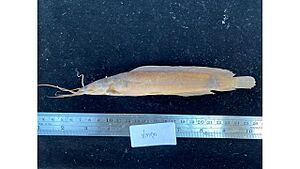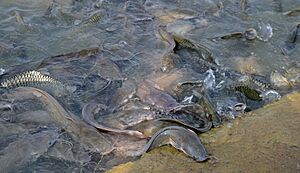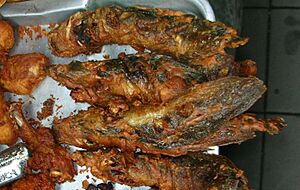Broadhead catfish facts for kids
Quick facts for kids Broadhead catfish |
|
|---|---|
 |
|
| Preserved specimen, possibly from Thailand. | |
| Conservation status | |
| Scientific classification |
The broadhead catfish (Clarias macrocephalus) is a special type of catfish that can breathe air! It comes from Southeast Asia and is very important for people there. People raise these fish in ponds for food in countries like Thailand (where it's called Thai: ปลาดุกอุย) and the Philippines.
Sadly, the wild broadhead catfish are in danger. Their numbers are shrinking because of human activities. Also, they sometimes breed with other types of catfish that have escaped from farms. This mixing of genes can harm the native fish. In Thailand, both this fish and the walking catfish (Clarias batrachus) are known as Pla Duk (Thai: ปลาดุก). They are a popular and affordable food. You can often find them sold by street vendors, especially grilled or fried.
Contents
What Does the Broadhead Catfish Look Like?
The broadhead catfish has a few special features. You can spot it by its large dorsal fin (the fin on its back). It also has a short, rounded part on its head called the occipital process. A close relative, the Clarias batrachus, has a pointed occipital process instead.
Another way to tell them apart is by the white spots on the sides of its black body. If you look closely at their underside, you can tell males from females. Males have a longer, pointed area near their anus, while females have a round opening. These catfish can grow quite large, up to 120 centimeters (about 47 inches) long!
Where Do Broadhead Catfish Live?

Broadhead catfish like to live near the bottom of the water. They can survive in both slightly salty water (called brackish water) and fresh water. These fish prefer warm, tropical places. You can find them in Asian countries like Thailand, Vietnam, China, Malaysia, Guam, and the Philippines.
They enjoy living in marshes, canals, rice fields, still pools, and rivers. If the water dries up during hot seasons, these fish can bury themselves in the mud and wait for a long time. If they need to move to a new water source, they can even crawl out of the water using their strong fins!
Why Are Broadhead Catfish in Danger?
Like other Clarias catfish, the broadhead catfish is threatened by human activities. Things like cities growing bigger and breaking up their natural homes are a problem. Also, the growing fish farming business can affect them.
One big threat comes from hybrid fish. These are new types of fish born from a female broadhead catfish and a male introduced C. gariepinus. These hybrid fish can breed with both original species. This can lead to a mixing of genes that might cause the native broadhead catfish to disappear. The hybrid fish also grow faster, which means they might take all the food and space from the native fish.
What Do Broadhead Catfish Eat and How Do They Reproduce?
Broadhead catfish are carnivores, meaning they eat meat. They munch on water insects, small shrimp, and tiny fish. But they can also eat things like rice bran, kitchen scraps, or special fish food.
Other creatures sometimes attack these fish, like certain types of water molds. In the wild, broadhead catfish lay their eggs in small streams. However, when they are raised on farms, they don't lay eggs on their own. Farmers have to help them by giving the female fish special hormones. The eggs are then collected from the female. Male reproductive cells are added to fertilize the eggs.
After the baby catfish hatch, they can be fed tiny brine shrimp and water fleas. After about a month, these young fish, called fingerlings, are big enough to be moved to larger ponds to grow.
Why Are Broadhead Catfish Important to People?
Broadhead catfish are sold in stores either alive or frozen. People cook them in many ways, like frying, grilling, or baking. They can also be put into cans, but usually, their black skin is removed first because it doesn't look very appealing.
Even though this fish grows slowly and doesn't produce many babies, people still prefer to farm it. This is because of its good looks and tasty meat. In Thailand, many people believe the broadhead catfish is better and more nutritious than the walking catfish.




